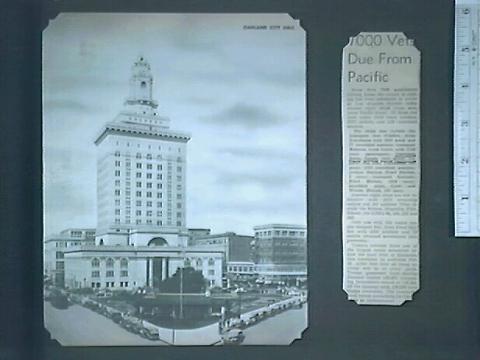H75.32.1ZZZ
Photographs.
ca. 1940-1950
10.25 in WIDE x 1.5 in DEEP
(26.03 cm WIDE x 3.81 cm DEEP)
(26.03 cm WIDE x 3.81 cm DEEP)
Gift of Lew Svendsgaard
H75.32.1ZZZ
Photograph album. Description: Album of M.V. Lloyd. Oakland home and friends and father's grocery store. This is a postcard manufactured by the Jumbo Post-Card Company, 2017 South Michigan Ave., Chicago 16, Illinois. It was distributed by United Card Company, 9863 Burr St., Oakland, Calif. The newspaper clipping refers to servicemen returning to civilian life from World War II.
(D. Cooper, 9/2002) The postcard shows the Oakland City Hall and the plaza in front of it.
From City Hall walk led by Chris Padilla, 7/2/96; West County Times, 7/13/96, Quake Disks Cushion Sites, by Elizabeth Hayes, Staff writer; AIA East Bay, "Pulling Downtown Oakland Together," Housing and Neighborhood Design Committee, 2nd Ed, 5/5/96
Base Isolators
The 1989 Loma Prieta earthquake left Oakland City Hall critically damaged. The clock tower was especially damaged. Large X-shaped cracks developed in the un-reinforced masonry and three of four major steel support beams were ruptured due to shear forces. The building had to be "red tagged."
More than 1800 tons of structural steel and 4,000 cubic yards of concrete were used for seismic reinforcement. A new 320-foot vertical steel frame was inserted under the building's faヘade with no visible intervention and 113 state-of-the-art Elastomeric Base Isolators were installed to dissipate seismic energy. These bearings stand about a foot tall and two feet in diameter, fitting between the building's foundation and the support columns. Constructed of layers of steel plates and rubber pads around a lead core, base isolators look like large rubber cylinders. They operate similarly to shock absorbers by preventing earthquake stresses from being transmitted to the building. They can move 18 inches in each direction in case of an earthquake. There is a 15-foot trench all around the building, with a "moat" 20 inches from the building.
A small East Bay company, Applied Structures Technology, LLC, developed the seismic isolators that go underneath the building, isolating the building from the horizontal motion of an earthquake.
Outwardly, the renovated building looks almost exactly as it did when it was built in 1914. Inside, however, it meets the standards for a modern high-rise office building.

© 2024 Oakland Museum of California
RIGHTS AND REPRODUCTION

